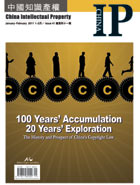
Guo seemed helpless over how these patents are produced more “efficiently.” In actual practice, she told our reporter, agents might even go so far as “creating” some innovative features for those soon-to-be-doomed patent applications. “We agents are practically becoming inventors,” she said with self mockery. “However, when we try to tell companies what’s in our mind, they refuse to understand and think we are just looking for money.”
In recent years,
“As a patent agent, I’m even more anxious to create valuable patents than corporations are,” Guo said. Usually regarded as a high-income group, patent agents have their bitter complaints.
Supportive Policies Cause Many Junk Patents
To encourage innovation,in recent years local governments have issued incentive policies for patents; setting up funds and offering other preferential treatment. This was effective and
You Minjian, lawyer in charge of IP affairs at Co-effort, a Shanghai-based law firm, stated, “The government support policy caused plenty of junk patents and a batch of agents who produce such junk. Service prices of the trade were also dragged down. Now in
Presently, this group of patent agents can be described by one word——busy. Every agent has piles of cases at hand and sometimes they are too busy to accept new cases. According to Ma Lianyuan, former president of All-China Patent Agents Association,
However, due to the amazing number of applicants, patent agency became a trade so hot that more and more firms joined in. Consequently, price cuts became an important competitive means. “Some enterprises, setting eyes on the government fund rather than patent quality, would usually choose agencies of lower price and inferior service,” a
However, enterprises were not the only ones who set eyes on supportive policies. College incentives to patent applications fueled enthusiasm among faculty and students, and scandals of junk patents were staged. Middle school and university students sought extra marks in college entrance and postgraduate exams, and some professors took it as a tool to obtain money. Supported by research funds and workplace subsidies, plenty of patent applications and numerous result-assessment meetings appeared.
Tian Lipu, commissioner of SIPO, said the country’s preferential policies were attra ctive. The encouragement is a good thing, but it might easily go astray. He believes “junk patents” are a problem at a certain stage of development which can be solved by more refned and scientifc administration and the incentives should focus on inventions and international patents.
You Minjian also said, “Government support should focus more on inventions which go global, because they are costly and competitive, and awards should be available for completed inventions.”
Flaws in Patent Examination
The epidemic of junk patents naturally led to finger-pointing at SIPO. The absence of substantive examination on design and utility model applications caused a large number of junk patents under these two categories. The Office has been placing emphasis on revising
Apart from an improved system, however, more doubts exist regarding patent examinations.
A researcher from a pharmaceutical company told of his personal experience on an online forum. He said, “Following our agent’s suggestions, our lab applied for six patents at the same time. But each carried no substantial difference, all being variations of one technology and only having unnecessary changes on a certain step of the process.” The result was that the applications went to different departments of examination, one to biomedicine, another to biological assessment and still another to material assessment. Four of them were finally rejected with different reasons, one didn’t receive any reply and only one stood the chance of being approved. The researcher couldn’t help asking: why did the applications, almost the same in nature, go to different departments? And why did the examiners have widely different perspectives and gave different reasons of refusal? Ironically, it was only at that point that the researcher understood his agent’s cunning in suggesting six patents simultaneously.
(Translated by Li Heng)
|
Copyright © 2003-2018 China Intellectual Property Magazine,All rights Reserved . www.chinaipmagazine.com 京ICP备09051062号 |
|
|



